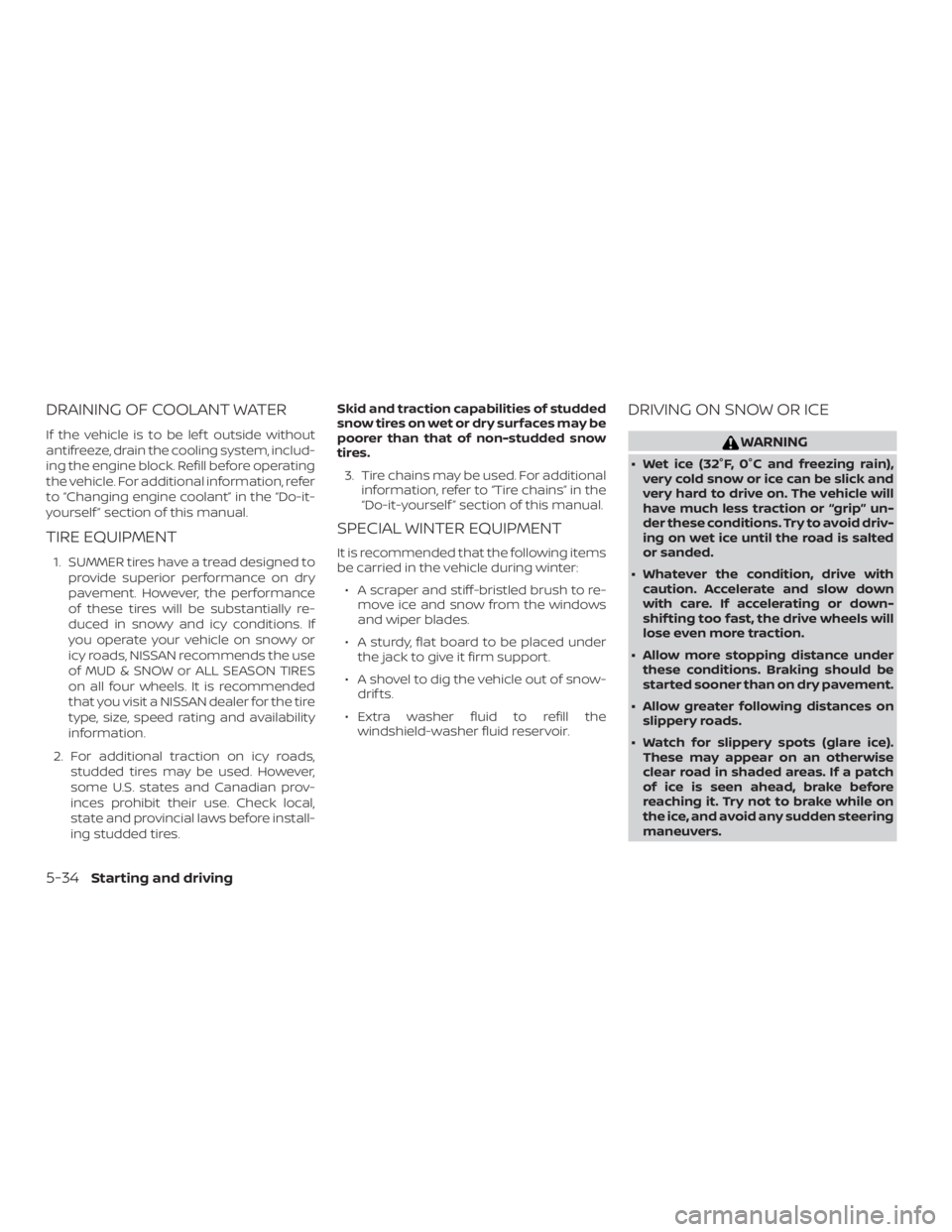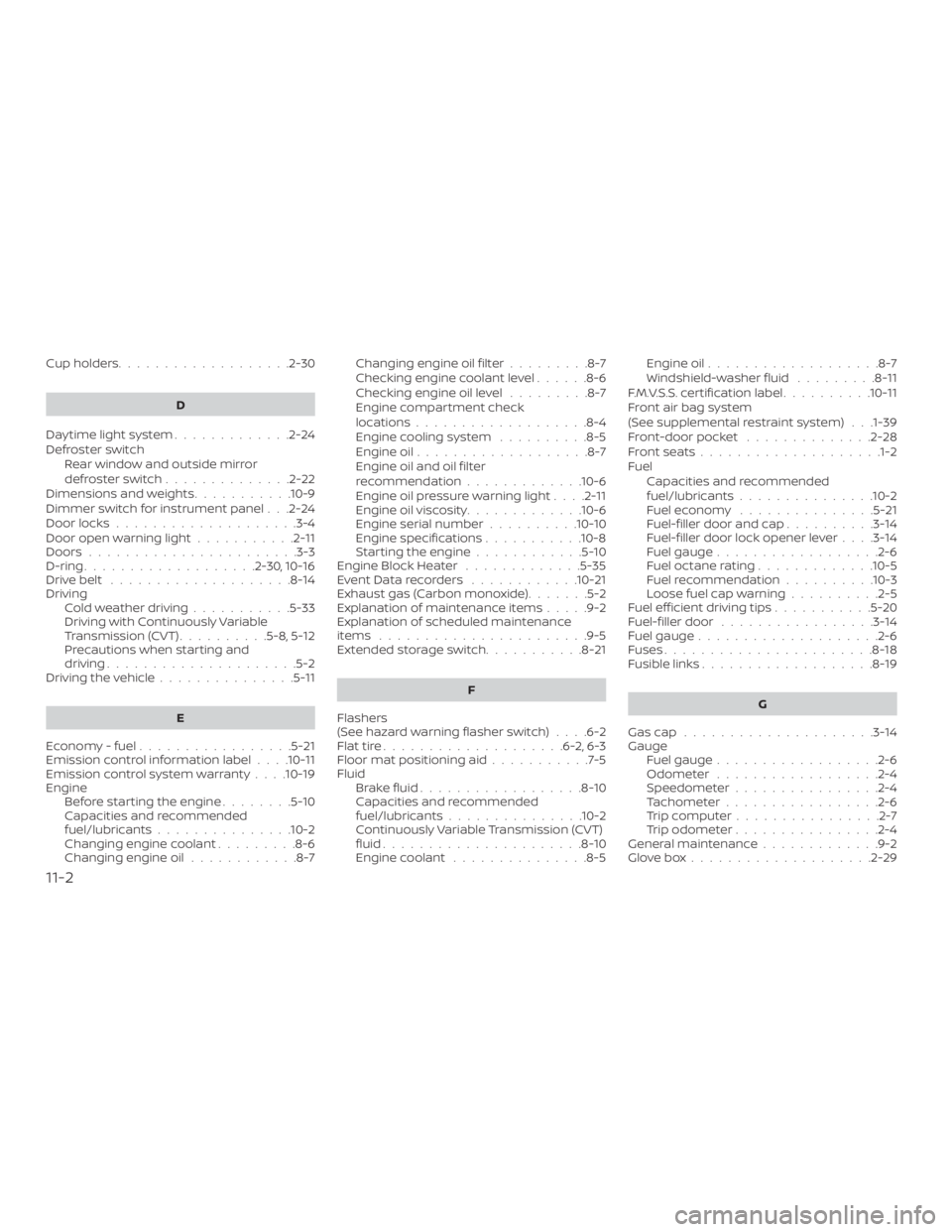Page 184 of 300

DRAINING OF COOLANT WATER
If the vehicle is to be lef t outside without
antifreeze, drain the cooling system, includ-
ing the engine block. Refill before operating
the vehicle. For additional information, refer
to “Changing engine coolant” in the “Do-it-
yourself ” section of this manual.
TIRE EQUIPMENT
1. SUMMER tires have a tread designed toprovide superior performance on dry
pavement. However, the performance
of these tires will be substantially re-
duced in snowy and icy conditions. If
you operate your vehicle on snowy or
icy roads, NISSAN recommends the use
of MUD & SNOW or ALL SEASON TIRES
on all four wheels. It is recommended
that you visit a NISSAN dealer for the tire
type, size, speed rating and availability
information.
2. For additional traction on icy roads, studded tires may be used. However,
some U.S. states and Canadian prov-
inces prohibit their use. Check local,
state and provincial laws before install-
ing studded tires. Skid and traction capabilities of studded
snow tires on wet or dry surfaces may be
poorer than that of non-studded snow
tires.
3. Tire chains may be used. For additional information, refer to “Tire chains” in the
“Do-it-yourself ” section of this manual.
SPECIAL WINTER EQUIPMENT
It is recommended that the following items
be carried in the vehicle during winter:
∙ A scraper and stiff-bristled brush to re- move ice and snow from the windows
and wiper blades.
∙ A sturdy, flat board to be placed under the jack to give it firm support.
∙ A shovel to dig the vehicle out of snow- drif ts.
∙ Extra washer fluid to refill the windshield-washer fluid reservoir.
DRIVING ON SNOW OR ICE
Page 199 of 300
5. Visually check drive belts for damageor looseness. Also check if the cooling
fan is running. The radiator hoses and
radiator should not leak water. If cool-
ant is leaking, the water pump belt is
missing or loose, or the cooling fan
does not run, stop the engine.
Page 215 of 300
The engine cooling system is filled at the fac-
tory with a pre-diluted mixture of 50% Genu-
ine NISSAN Long Life Antifreeze/Coolant
(blue) and 50% water to provide year-round
antifreeze and coolant protection. The anti-
freeze solution contains rust and corrosion
inhibitors. Additional engine cooling system
additives are not necessary.
Page 216 of 300

CHECKING ENGINE COOLANT
LEVEL
Check the coolant levelin the reservoir
when the engine is cold. If the coolant
level is below the MIN level, add coolant to
the MAX level. If the reservoir is empty,
check the coolant level in the radiator
when the engine is cold. If there is insuffi-
cient coolant in the radiator, fill the radiator
with coolant up to the filler opening and
also add it to the reservoir up to the MAX
level. This vehicle contains Genuine NISSAN Long
Life Antifreeze/Coolant (blue). The life ex-
pectancy of the factory-fill coolant is
105,000 miles (168,000 km) or 7 years. Mixing
any other type of coolant or the use of
non-distilled water will reduce the life ex-
pectancy of the factory-fill coolant. For ad-
ditional information, refer to the “Mainte-
nance and schedules” section of this
manual.
The engine coolant reservoir is a pres-
surized tank. When installing the cap,
tighten.
If the cooling system frequently requires
coolant, have it checked. It is recom-
mended that you visit a NISSAN dealer
for this service.
CHANGING ENGINE COOLANT
A NISSAN dealer can change the engine
coolant. The service procedure can be
found in the NISSAN Service Manual.
Improper servicing can result in reduced
heater performance and engine over-
heating.
Page 290 of 300

Cupholders...................2-30D
Daytime light system .............2-24
Defroster switch Rear window and outside mirror
defrosterswitch..............2-22
Dimensions and weights ...........10-9
Dimmer switch for instrument panel . . .2-24
Door locks ....................3-4
Door open warning light ...........2-11
Doors .......................3-3
D-ring ...................2-30,10-16
Drivebelt ....................8-14
Driving Coldweatherdriving...........5-33
Driving with Continuously Variable
Transmission (CVT) ..........5-8,5-12
Precautions when starting and
driving .....................5-2
Drivingthevehicle...............5-11
E
Economy - fuel .................5-21
Emission control information label . . . .10-11
Emission control system warranty . . . .10-19
Engine Before starting the engine ........5-10
Capacities and recommended
fuel/lubricants...............10-2
Changing engine coolant .........8-6
Changing engine oil ............8-7 Changing engine oil filter
.........8-7
Checking engine coolant level ......8-6
Checking engine oil level .........8-7
Engine compartment check
locations...................8-4
Engine cooling system ..........8-5
Engine oil ...................8-7
Engine oil and oil filter
recommendation .............10-6
Engine oil pressure warning light ....2-11
Engine oil viscosity .............10-6
Engine serial number ..........10-10
Engine specifications ...........10-8
Starting the engine ............5-10
Engine Block Heater .............5-35
EventDatarecorders ............10-21
Exhaust gas (Carbon monoxide) .......5-2
Explanation of maintenance items .....9-2
Explanation of scheduled maintenance
items .......................9-5
Extended storage switch ...........8-21
F
Flashers
(See hazard warning flasher switch) ....6-2
Flattire....................6-2,6-3
Floormatpositioningaid...........7-5
Fluid Brakefluid..................8-10
Capacities and recommended
fuel/lubricants...............10-2
Continuously Variable Transmission (CVT)
fluid......................8-10
Engine coolant ...............8-5 Engine oil
...................8-7
Windshield-washer fluid .........8-11
F.M.V.S.S. certification label ..........10-11
Front air bag system
(See supplemental restraint system) . . .1-39
Front-door pocket ..............2-28
Frontseats....................1-2
Fuel Capacities and recommended
fuel/lubricants...............10-2
Fuel economy ...............5-21
Fuel-filler door and cap ..........3-14
Fuel-filler door lock opener lever . . . .3-14
Fuel gauge ..................2-6
Fueloctanerating.............10-5
Fuel recommendation ..........10-3
Loosefuelcapwarning..........2-5
Fuel efficient driving tips ...........5-20
Fuel-filler door .................3-14
F
uel gauge ....................2-6
Fuses .......................8-18
Fusiblelinks...................8-19
G
Gascap .....................3-14
Gauge Fuel gauge ..................2-6
Odometer ..................2-4
Speedometer ................2-4
Tachometer .................2-6
Trip computer ................2-7
Trip odometer ................2-4
General maintenance .............9-2
Glovebox....................2-29
11-2